TLDR –
The Phoenix provides a hyper-attractive visual and auditory experience with a tuning that showcases its profuse technical ability first and foremost.
Introduction –
Astrotec was founded almost 2 decades ago in Shenzhen with the pursuit of innovation and excellence. Since then, they’ve created some of the finest and most exclusive earbuds on the market alongside a line of more value-orientated IEMs. The designers at Astrotec couldn’t stop there, however. Enter the Phoenix, the company’s first flagship IEM. Here, Astrotec pairs cutting-edge electro-static tweeters found more commonly on summit-fi monitors costing multiples more with a huge, custom dynamic driver. Alongside authentic rosewood and titanium alloy housings, creating an optimal acoustic environment, the Phoenix promises a highly resolving and engaging sonic performance that exceeds its not insubstantial $799 YUSD asking price. This is another intriguing almost value-orientated flagship from a company with a rich heritage in quality audio and design. You can read more about the Phoenix and treat yourself to one
here.
Disclaimer –
I would like to thank Astrotec very much for their quick communication and for providing me with the Phoenix for the purpose of review. I would also like to thank the company for being so supportive when my initial unit was damaged in the mail. All words are my own and there is no monetary incentive for a positive review. Despite receiving the earphones free of cost, I will attempt to be as objective as possible in my evaluation.
Specs –
Driver Unit: Dual Electrostatic super tweeters+ customized dynamic driver
Impedance: 32 ohms
Sensitivity: 85 dB/1mW
Cable: 6N OCC mixed with Kevlar
Cable Length: 1.2m
Connector: MMCX
Frequency Response: 5Hz – 40000Hz
The Pitch –
Electrostatic tweeters
Sonion quite recently released dual and quad electrostatic tweeter systems that have been the buzz of the high-end IEM world. Electrostatic drivers as many will know from boutique Hi-Fi speakers implement an ultralight charged membrane manipulated by static force, functioning very differently to other driver types. As there is no magnetic trace like a planar magnetic driver, the membrane is even thinner and lighter for a more accurate transient response. Furthermore, force application is exceptionally uniform for very low distortion high frequencies.
True electrostatic drivers represent the pinnacle of high-precision sound reproduction but are difficult to miniaturise, as they must be driven by a high voltage source and struggle to reproduce deep bass. To circumvent this challenge, Sonion introduced a micro-transformer to omit the need for an external high-voltage amp. However, as a result, the sensitivity is especially low so finding suitable bass drivers to match has been an ongoing challenge for manufacturers. Astrotec circumvents this by implementing a large, custom dynamic driver and through delicate tuning of the surrounding acoustics to unite their sound into a coherent whole.
Tuned Acoustics
The Phoenix features authentic rosewood shells in addition to high-precision titanium and aluminium faceplates. Wood is dense and naturally anti-resonant, in the case of the later, more so than plastic and metal. It is a preferred material in speaker design as a result and has been implemented in the past for IEM designs to good effect. In addition, the nozzle implements a brass construction, all providing the ideal acoustic environment for the driver setup inside in addition to tailoring the frequency response to Astrotec’s specifications.
Unboxing –
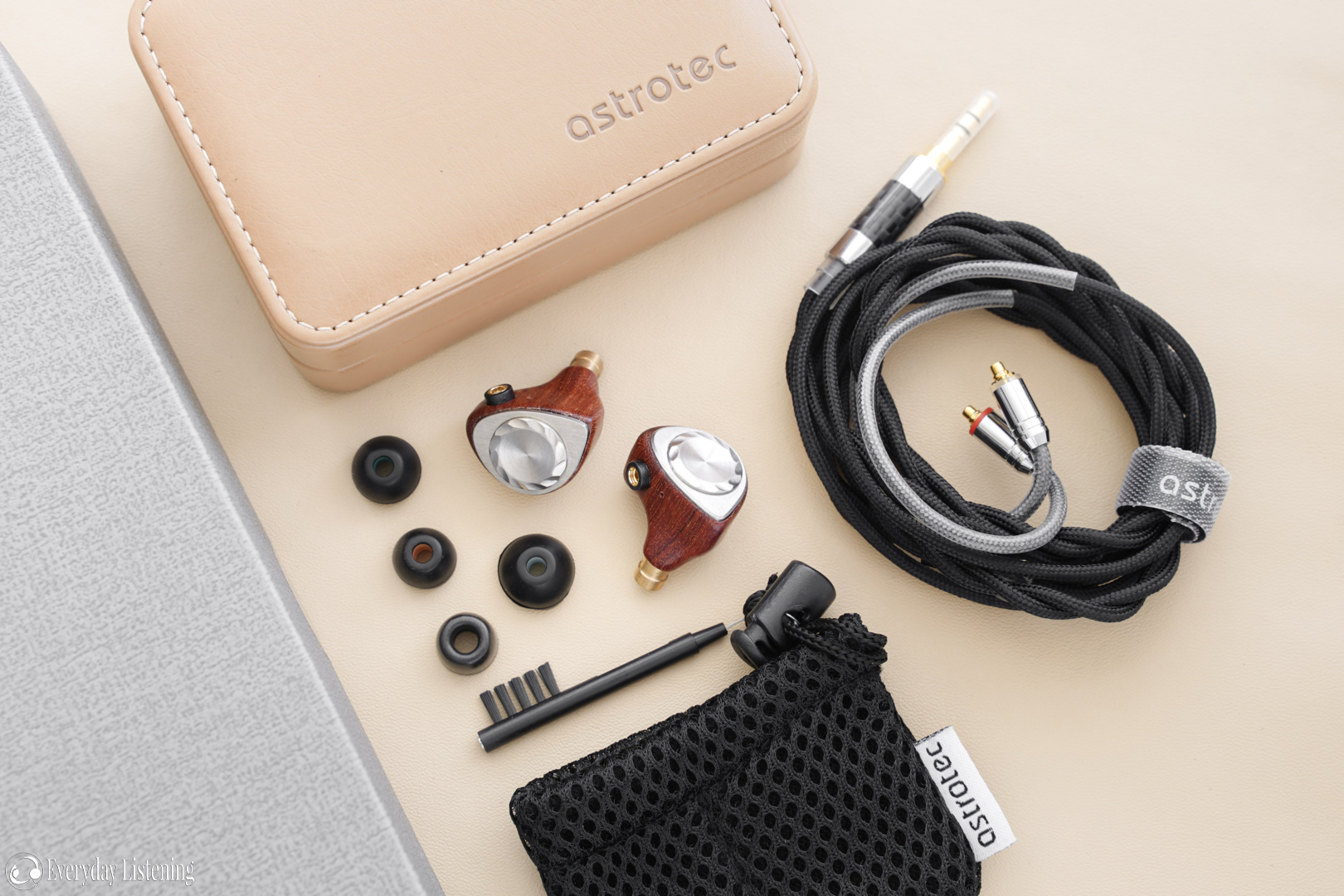
Astrotec always provides a premium unboxing experience and the very same is exemplified with their flagship Phoenix. Inside an attractive glittered sleeve lies a linen-textured hard box. The earphones are nestled within protective form inside with the leather carrying case and other accessories below. Included are 3 pairs of Sony Hybrids, a pair of memory foam tips, a cleaning tool and a dual compartment sleeve similar to that included with Campfire Audio’s earphones. The sleeve is a protective and pocketable solution with separate compartments for each earpiece and a spongey construction that protects from drops and scratches. The included leather case looks very premium. Unfortunately, it isn’t usable as there is a cable-management pillar in the centre that makes it impossible to accommodate the housings without removing the cable first, hardly practical nor good for wear and tear. I have been informed that later batches come without the pillar which should alleviate this issue.
Design –
As aforementioned, the material choice is opulent and exclusive with a genuine rosewood construction and delicately textured metal faceplates. They assume a pod-shaped housing but with a taller profile similar to the Meze Rai Penta. As such, though large, they occupy the empty space of the outer ear to maximise comfort and it forms an attractive shape with clean lines overall. I’m also nostalgic to see the return of wood housings as I haven’t recalled an earphone with such a construction since the JVX FX-range, all of which possessed very pleasing sounds as well.

And in person, the Phoenix is simply gorgeous; even the best photographs cannot encapsulate the unique wood grain of each hand-finished shell. The level of finish is excellent with gently curved edges and contours showcasing not one noticeable imperfection or frayed edge. Such a complexion is very difficult to achieve with wood and is certainly befitting of a flagship product. The brass nozzle complements their rustic aesthetic while enhancing the acoustics of the earphone. A small but appreciated touch are the reinforced MMCX connectors on the housings themselves; with plastic anchoring addressing an otherwise common point of failure.
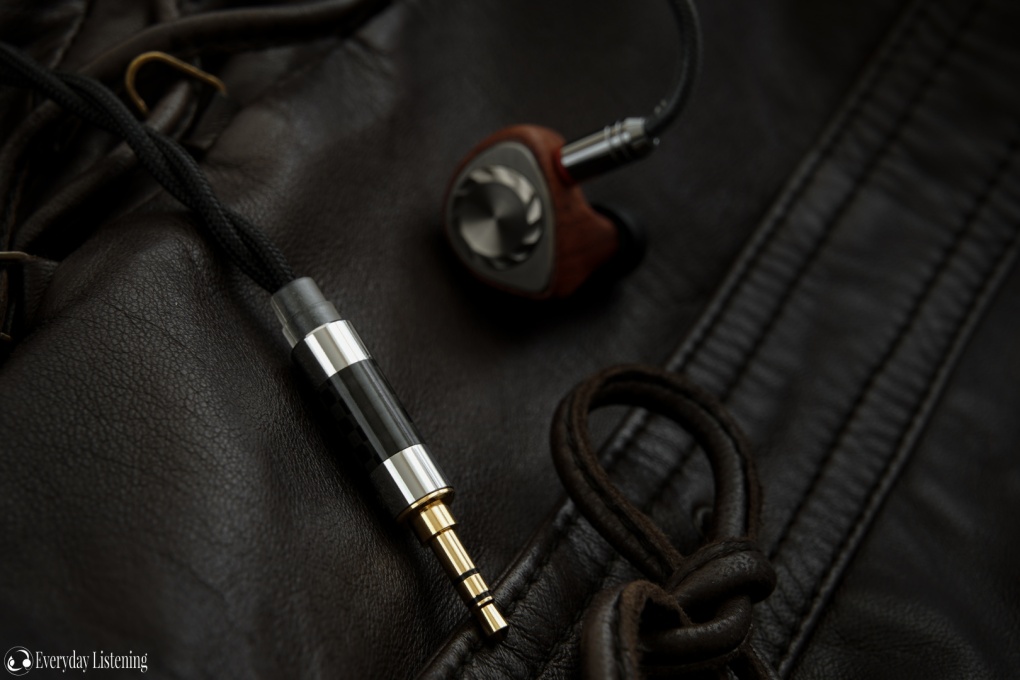
I am also very impressed with the stock cable. It’s an MMCX unit with 6N OCC conductors, internal Kevlar reinforcement and a soft fabric jacket that looks simply dapper with the wood housings. Though thick, the cable is supple and compliant making it unobtrusive to comfort. They may wiggle loose during active use but realistically that is not the intended use case of a high-end IEM and they posed no issue to me during daily use. Tangles are also not a problem and there is minimal memory or springiness. The cable has a uniform aesthetic with matching chrome finish on all metal terminations. The 3.5mm straight jack feels well relieved and the pre-moulded ear guides sustain the weight of the earphones and thicker cable comfortably.
Fit & Isolation –
Ergonomics are a strong point for the Phoenix, they slot confidently into the ear, complementing each curve and fold. There’s a gentle fin for the concha to aid fit stability and, though on the larger side, the majority of their dimension is derived from their width. They don’t provide a low profile fit but also don’t feel as large as they look in wearing as a result. I experienced no hotspot formation over several hours of listening and found them perfectly comfortable to wear as a result. They seal very well, and isolation is excellent for a vented hybrid earphone though the front-facing vent is susceptible to wind noise when listening outdoors. I found them to provide easily enough isolation for commute but naturally a bit less than a fully sealed unit.
Sound –
Testing Methodology: Measured using Arta via IEC 711 coupler to Startech external sound card. Note that 7-9KHz peaks are often artefacts of my measurement setup. Measurements besides channel balance are volume matched at 1KHz. Take this graph with a grain of salt.
Tonality –
The Phoenix provides an aggressive W-shaped sound that is immensely engaging but also reasonably balanced between each core frequency band. We observe a prominent low-end focused mainly on the sub-bass before a sharp rise through the centre midrange to redeem vocal presence. A sizeable peak in the upper-midrange brings vocals forward and roughly in line with their meaty bass while also serving to enhance clarity. It has a natural tonality, nonetheless. Highs are crisp and very clean with a dark background while energy is provided by an upper-treble lift that imbues copious sparkle and micro-detail.
Tip Selection
I was not personally a fan of the fit provided by the stock Sony Hybrid-style ear tips. I found Spiral Dots to provide the best combination of comfort and sound. As compared to the stock tips, they yielded a slightly smoother and denser midrange that sounded more coherent to my ear. I also noticed and more linear low-end, attenuating the sub-bass just a touch. These were my preferred tip and will be used for the sound impressions below.
Bass –
Lows are defined by huge power, weight and dynamics derived from generous sub-bass emphasis alongside terrific extension into the sub-audible. There’s solid but not over-bearing pressure at the very bottom alongside heaps of slam and a bold yet highly defined rumble. Meanwhile, a steep slope through the mid and upper-bass ensures bass isn’t overly tubby, warm or congested. Note size is huge yet there isn’t any bloat and the tone is only slightly warm. This isn’t a rich and smooth low-end, but a large and hard-hitting one with great body while avoiding the usual fallibilities of such an enhanced low-end by keeping the mid and upper-bass clean. As sub-bass pressure doesn’t overwhelm the low-end presentation, there’s good definition through the mid-bass and it doesn’t fatigue the ear during long listening sessions.
The earphones showcase strong technical performance too with excellent control that ensures its large notes remain defined and that small details aren’t hazed over. Sub-bass, despite its sheer volume, is detail dense with very concise impact. Attack is hard-hitting and decay is on the slower side, exemplifying the rumble and dynamics signature to dynamic drivers while serving to enhance the perception of bass presence and size. As control is high, the presentation isn’t sloppy or disorganised, resolution is excellent through the low-end and each note retains defined and well-separated. The Phoenix I would struggle to call a bass-head earphone in lieu of similarly potent midrange and top-end emphasis, though it is certainly an earphone that would appeal to bass lovers with its deep, voluminous and highly dynamic image.
Midrange –
I’m usually very averse to 4KHz prominent earphones, but recently, I’ve been forced to re-evaluate that belief as more earphones adopt this tuning and come across quite pleasantly to me. The Phoenix is such an earphone and though certainly off-timbre in some regards due to this tuning, it forms an overall natural image. Both upper-bass and lower-mids are attenuated to reduce colouration. A rise through the centre midrange before a peak at 4KHz brings vocals forward to sit just a hair behind the low-end. Chestiness and muffle are mitigated as a result and vocals also aren’t too forward or intimate in the context of their large bass and treble. I hear a pleasantly transparent tone and outstanding clarity. Vocals achieve accurate size and occupy an enjoyable position within the Phoenix’s stage.
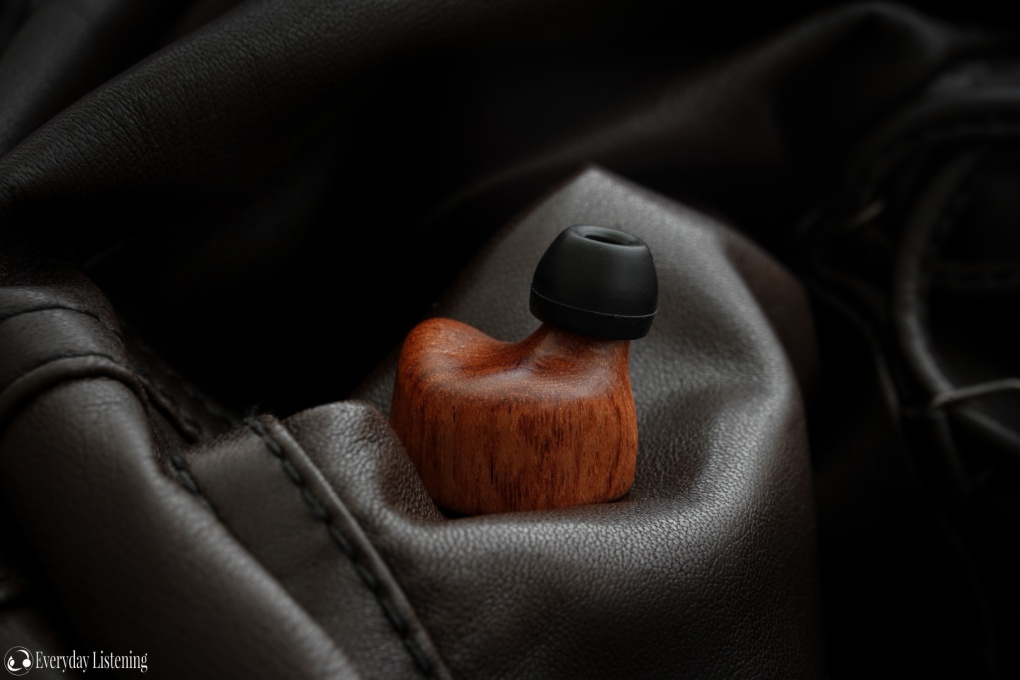
As the lower-treble has been attenuated, though very clear and of reduced density, vocals are smoothly articulated and refined without stridence or sibilance. Still, this isn’t a perfectly coherent presentation, being stretched slightly thin due to upper-midrange emphasis and vocals are somewhat raspy. There’s also a slight bias towards female and male vocals are prone to dryness due to the scoop in the lower-midrange similar to earphones like the Hyla CE-5. No, this won’t be called a linear or reference earphone nor is it organic or warm, but its adjustments are well-compensated to provide a very engaging presentation without overly skewing the timbre. The Phoenix thereby upholds good overall balance and provides a very pleasant, delicate and defined midrange presentation.
Highs –
The top-end is quite different to most earphones I’ve heard with both positive and negative connotation. For one, timbre is not especially accurate. The lower-treble has reduced presence, so foreground detail presentation isn’t overly aggressive and sibilance is mitigated. However, as there is a moderate 7-8KHz peak, instruments remain very crisp and defined but do lack body without that lower-treble foundation. Percussion is especially emphasized working in conjunction with a
superbly clean transient response, sharp attack and natural decay yielding well-textured notes, nonetheless. Cymbals retain pleasing shimmer and the presentation isn’t glaring or splashy. However, this does serve to reinforce the thinness of its presentation. What saves the Phoenix from becoming harsh or strident is its clean, dark background which aids a composed image alongside a well-layered one.
Treble also does sit slightly behind the bass in overall quantity which prevents the impression of overt brightness or in your face sharpness. As it commands strong contrast with the midrange, treble details are never lost in the mix, remaining highly defined. It is with regards to technical performance that the Phoenix excels. Detail retrieval is strong, just lacking some bite in the foreground, but micro and background-detail retrieval exceed its asking price. The Phoenix brings minutiae to the fore and showcases very strong extension into the highest octaves. There’s abundant sparkle with strong 16KHz presence that ensures background details are always apparent despite its dark background, and the Phoenix has resolution in spades. If you don’t mind a rather thin foreground presentation, the Phoenix is able to effortlessly deconstruct the smallest details in complex tracks.
Soundstage –
With excellent extension alongside a dark background, the Phoenix crafts a large soundstage that extends beyond the head in all axis. Vocals are mostly forward, creating a generally more oval presentation, but the earphone is able to project great depth on appropriate tracks as well. The presentation is very involving and imaging performance also is not as unorthodox as its tuning might suggest. Vocals occupy a strong centre image while instruments fan out to the sides. Directional cues are very sharp and localisation is reasonably precise too but less pinpoint accurate than some due to a lack of lower-treble presence. Panning and transients are swift and immersive. Separation is excellent between the 3 core frequency bands and also operates at a high level within them, especially the treble where its clean transient response contributes to very defined individual notes.
Rambles
The soundstage is an especially elusive quality to judge as a reviewer, especially on the in-ear form factor as the way sound interacts with the ear is very different to headphones and speakers due to the lack of interaction with the outer ear. You will find most reviews contradict in this regard. I personally was of the belief that treble performance contributed most to the soundstage presentation. However, after a discussion with Paul from About Audio, we determined that the bass plays a large role too. The Phoenix exemplifies this, its grand low-end contributing volume and size to its presentation. Take a listen to Yosi Horikawa’s signature “Bubbles” and you’ll see what I’m talking about. This will be a factor in my reviews henceforth.
Driveability –
The Phoenix has a modest impedance of 32ohms but a noticeably low sensitivity of 93dB. For reference, as far as volume is concerned, they require about as much voltage as the over-ear planar magnetic Hifiman Sundara. As such, a dedicated source or, at the very least an external amplifier is highly recommended to extract optimal volume and performance from the Phoenix.
Pixel 4 & DD TC35B: A good demonstration of a lower-powered phone source with low OI. Noticeably reduced sub-bass extension with blunted slam and reduced volume. Mids are clean and transparent, slightly grainier than my reference desktop setup. The top-end is clean and well-detailed but a touch brighter and less textured. The soundstage remains wide and nicely layered but lacks background detail retrieval.
With Periodic Ni: The setup gains ~40% more volume. Sub-bass extension is improved with perceptibly more solid slam and rumble. Bass is more control with more definition through the mid-bass. Vocals are slightly smoother and more refined with a touch more body. The top-end remains clean and nicely detailed. The soundstage becomes wider with better separation and a cleaner background.
Shanling M2X: Reduced sub-bass extension with lighter slam at the very bottom and less volume. Control is strong and definition is high. Mids are clean and transparent, a touch more forward and less smooth. Highs are well-detailed with very clean transient response and good extension. The soundstage is wide with sharp imaging, slightly less defined layers but good separation overall.
Hiby R6: The R6 has a 10-ohm output impedance that can skew the signature of multi-driver IEMs. The R6 provides strong sub-bass extension, control is good, slightly longer decay for a warmer voicing. The midrange remains transparent, slightly more intimate vocals. Highs are crisper and more forward, very detailed. The soundstage isn’t as wide, but imaging remains very sharp. Overall, the Phoenix isn’t excessively affected by output impedance but does sound brighter from these sources.
iBasso DX220: The portable source that came closest to the desktop setup in my inventory. The DX220 provided strong sub-bass extension and control. Mids were clean and transparent. Highs were very well detailed, slightly more so in the foreground. Excellent resolution with a wide soundstage and sharp localisation.
THX 789 + Khadas Tone Board: My current reference desktop setup with a transparent sound and heaps of clean power. Excellent bass extension, tight with excellent control. Transparent midrange, clean top-end with great resolution and detail retrieval. Wide soundstage with sharp localisation and good separation.
Suggested Pair ups
In my testing, only the larger and higher-end DAPs or a reasonably powerful dedicated amplifier like the Periodic Ni were suitable in terms of driving power. This was especially apparent when it came to bass extension where the smaller sources provided a noticeable drop-off. Still, even the TC35B provided a resolving and balanced sound and the Phoenix resists hiss and output impedance well. Though, as always, a lower OI will keep the sound closest to that intended by the designers. This is one of the few earphones that scales with a desktop amplifier which provided a notice jump even over the DX220 when it came to staging and extension. The Phoenix’s voicing to my ears, best suits a neutral source as its low-end can become dominant on a warmer source and similarly, it’s top-end can become sharp on brighter sources. The delicate balance of the earphone is best showcased by neutral and powerful sources such as the THX 789 or JDS Atom if you’re on a budget, you would not want to run the Phoenix from a smartphone or entry-level BT receiver.
Comparisons –
Custom Art Fibae 6 ($799): A well-performing warm and smooth earphone from a respected Polish company. It sports a 6-BA setup and a uniquely warm, thick tuning. Bass extension is better on the Phoenix and it has more sub-bass emphasis. Meanwhile, the 6 provides a meatier mid and upper-bass. Its low-end is fuller and warmer but also more bloated. With quicker but still reasonably natural decay, the 6 doesn’t gloss over too many fine details but the Phoenix is more defined through its low-end. Both showcase excellent control and dynamics.
Both also see moderate midrange emphasis to bring vocals in line with their prominent low ends. The 6 is a bit more linear, its vocal reconstruction is fuller and warmer but also very clear on behalf of similar 4KHz prominence. The 6 sounds more organic, never congested or muffled and a bit more natural overall. Both are smoothly articulated, the Phoenix is more neutral in tone and has better clarity and separation.
The 6 has a small 6 and 8KHz peaks but its treble is smooth and laid-back relative to its mids and bass. As such, the 6 has a very different presentation, being much smoother and warmer with enhanced body. The Phoenix is more detailed, especially when it comes to micro-detail retrieval. The 6 has more defined layers but clearly lacks the same sparkle and resolution up top. The Phoenix has a wider soundstage and better separation while the ME has slightly sharper localisation.
NXEars Opera ($799): The Opera is an 8-BA earphone with a mid-focussed sound and some very interesting properties. It has a substantially less dynamic and involving low-end with significantly less extension. In terms of tuning, it is less bassy overall but as focus lies in the upper-bass, it remains quite a full sound. The Opera has much faster decay so it doesn’t come across as too warm to me, yet showcases much higher definition while the Phoenix is meatier, thicker and weightier.
Through the midrange, they also diverge quite apparently. The Opera is full-bodied, dense and focussed on timbre while the Phoenix is the inverse, very clear, neutral in tone and high in clarity. The Phoenix has better extension and greater definition and separation while the Opera is more natural and with larger vocal size and a slightly more intimate presentation. The Opera is noticeably more layered too while upholding similar definition. Up top, the Phoenix is noticeably crisper with an even cleaner transient response.
The Opera provides a bit more linearity through the treble with a more present lower-treble but both are somewhat thin up top, the Phoenix more apparently so due to its higher contrast and, by extension, lower coherence. The Opera is more detailed in the foreground while the Phoenix has better micro-detail retrieval alongside superior extension and sparkle. The Phoenix has a noticeably larger soundstage in all aspects while the Opera has uniquely sharp localisation and imaging on behalf of its time-aligned crossover. The Opera has more defined layers and better separation.
Hyla CE-5 ($940): Actually, the CE-5 and Phoenix quite resemble each other which speaks well for the Phoenix as the Hyla has become quite a legendary IEM. The Phoenix has slightly more bass alongside greater sub-bass weight, the Hyla is more linear between sub and mid-bass. Extension and control are excellent on both, the Hyla has natural decay while the Phoenix lingers a little longer, enhancing the thickness of its bass notes. The Hyla is more insightful as a result, while the Phoenix is more dynamic and engaging. Both earphones implement quite a sharp upper-bass/lower-midrange dip before a more present centre midrange.
The Phoenix doesn’t sound as forward as the Hyla in lieu of its bigger bass. The Phoenix is slightly fuller, especially male vocals, but also slightly raspier due to its more forward upper-midrange. The Phoenix has smoother articulation and is less prone to sibilance due to its substantially less present lower-treble and its midrange has more body and smoothness which contributes to a more natural image to my ears while upholding similar clarity and cleanliness. The CE-5 has a more linear treble with small 5 and 7KHz bumps. It has a bit more body, texture and detail retrieval in the foreground while the Phoenix is thinner and its notes lack the same initial bite. However, when it comes to micro-detail retrieval, the Phoenix has a slight edge, resolving finer background details and sparkle more convincingly.
The Hyla has a bit more air while the Phoenix has a darker and cleaner background, both have abundant of sparkle at the very top, the Phoenix again sounds a bit cleaner and more composed. Both have similar soundstage width, the Hyla has a touch more depth due to its more laid-back upper-midrange. To clarify, due to its bigger sub-bass, the Phoenix often sounds grander in presentation though perceived distance is similar under scrutiny. Both also have very sharp imaging with very swift transients, localisation is sharper on the Hyla due to its more linear lower-treble.
Campfire Audio Andromeda 2018 ($1099): The Andromeda is also a resolving, sparkly IEM, and represents a more linear W-shaped sound. It has less sub-bass extension and bass overall but similarly carries satisfying weight and fullness down low with moderate sub and upper-bass emphasis. The Phoenix is thicker, harder-hitting and slower decaying but also more dynamic, it resolves more information at the very bottom especially. Meanwhile, the Andro is much quicker decaying resulting in higher definition and fine detail retrieval but also less textured notes. The Andromeda is a lot more linear through the midrange and has a more integrated bass/midrange transition for a more coherent sound overall.
It has more present vocals and they are endowed with a euphonic warmth and body from the upper-bass and lower-midrange. Meanwhile, the Phoenix has more contrast but sounds less coherent and less balanced between male and female vocals. With more upper-midrange bias, it sounds clearer and cleaner in tone but also stretched thinner and more strained with more rasp. The Andromeda on the contrary, can come across as a bit laid-back in the upper-midrange. Its vocals generally occupy a more distant position in the stage besides the occasional track where male vocals can sound more distant on the Phoenix. The Andromeda carries higher resolution overall and is smoother, fuller and more natural in voicing where the Phoenix is more engaging.
The Andromeda has similar areas of emphasis in the treble with the addition of a small lower-treble peak while continuing the trend of being generally more linear in tuning. The Andromeda’s treble has more body, foreground detail retrieval is a bit higher and instruments such as cymbals have more texture and accurate shimmer. The Phoenix has sharper transients with a bit more emphasis on percussion. The Phoenix has a darker, cleaner background and slightly more resolution of micro-details. Both have excellent sparkle and extension, though slightly more apparent on the Andromeda. The Phoenix has a wider soundstage, the Andromeda has more depth and is more rounded in presentation. The Andromeda has sharper localisation, the Phoenix is more separated.
Verdict –

From my comparisons, we can observe how the Phoenix undercuts many competitors while offering more than parity in technical performance. Its tuning is sculpted, naturally making it more polarising than more balanced models. Though arguably, when reaching the upper echelons of pricing, flatness is no longer key as such can be had for much, much less. The Phoenix offers some contrast with its immensely fun, engaging and simply enjoyable signature, all the while upholding convincing overall balance that maximises its appeal. The Phoenix also exemplifies the high-end IEM experience with its gorgeous and premium construction with a comfortable fit. Perhaps most polarising will be its treble, as the lower-treble does sound quite laid-back which can affect instrument localisation and sap detail presence and instrument body. Source matching is also especially critical given the sensitivity. Still, what the Phoenix provides is a hyper-attractive visual and auditory experience alongside a tuning that showcases its profuse technical ability first and foremost. Those wanting huge, dynamic bass set to clear, delicate mids and sparkly highs will find few that contend with the Phoenix, especially around its asking price.
The Astrotec Phoenix is available from on Astrotec (International) for $799 at the time of writing. I am not affiliated with Astrotec and receive no earnings from purchases through this link
Thanks for reading! If you enjoyed my review, please see my website for more just like it!
Track List –
Billie Eilish – don’t smile at me
brb. – relationshit
Catherine Feeny – Hurricane Glass
Emotional Oranges – The Juice: Vol. II
Father John Misty – Pure Comedy
Kanye West – Only One
Joji – Sanctuary
Missy Higgins – The Sound of White
Nirvana – Nevermind
Radiohead – Pablo Honey
Radiohead – The Bends
Rich Brian – The Sailor
The Cranberries – No Need to Argue
Winner – Remember
Yosi Horikawa – Wandering

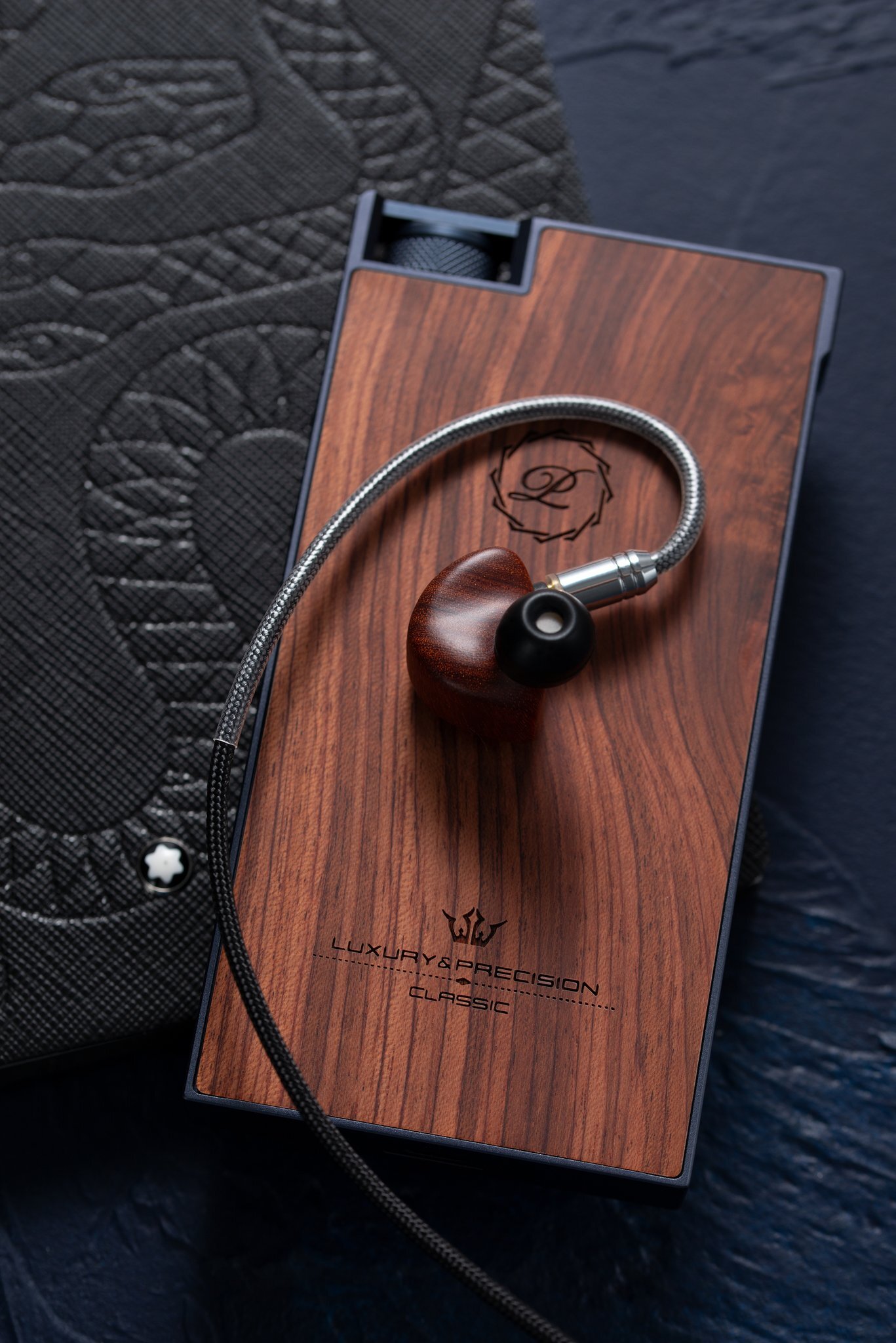








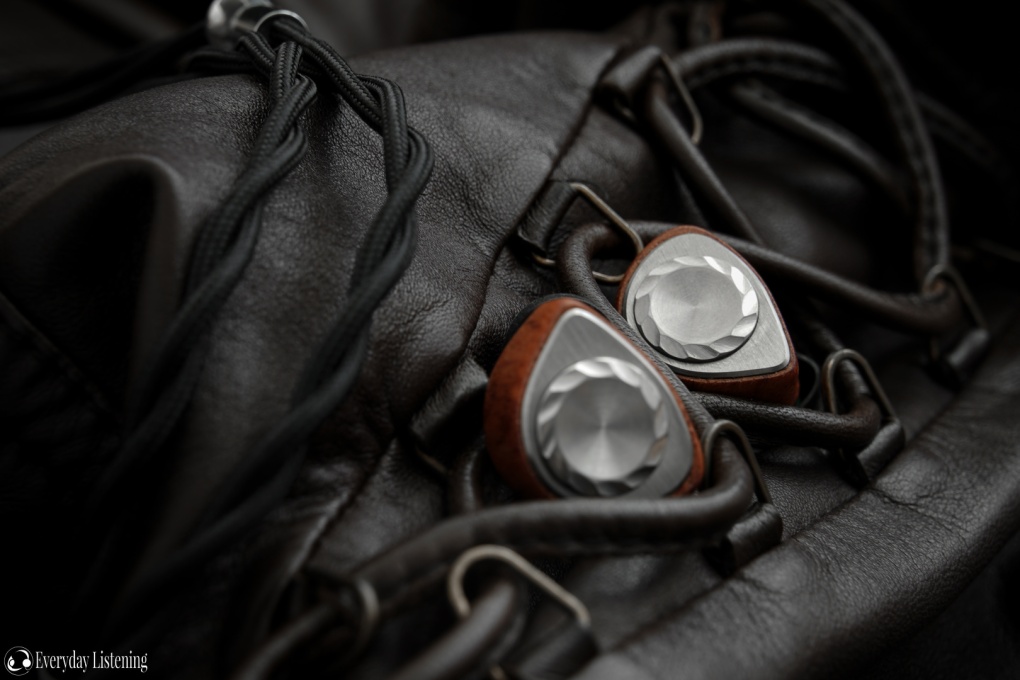

















for the bass - does it extend better and is emphasized/presented in a bigger way? solaris bass was nice but didn't give me that full DD feel.
and are the highs more extended by any chance due to the ESTs? or are they on par?
if anything that means my purchase is an automatic win, since i sold solaris OG because of hiss, lackluster bass, and overblown mids.
phoenix sounds like it has all of these fixed up